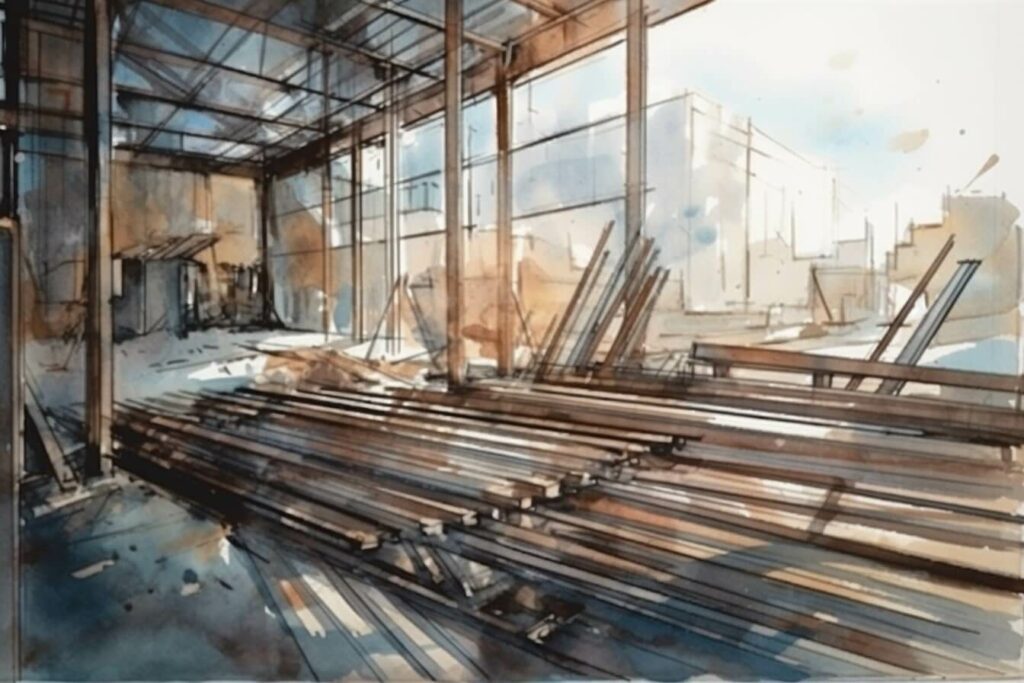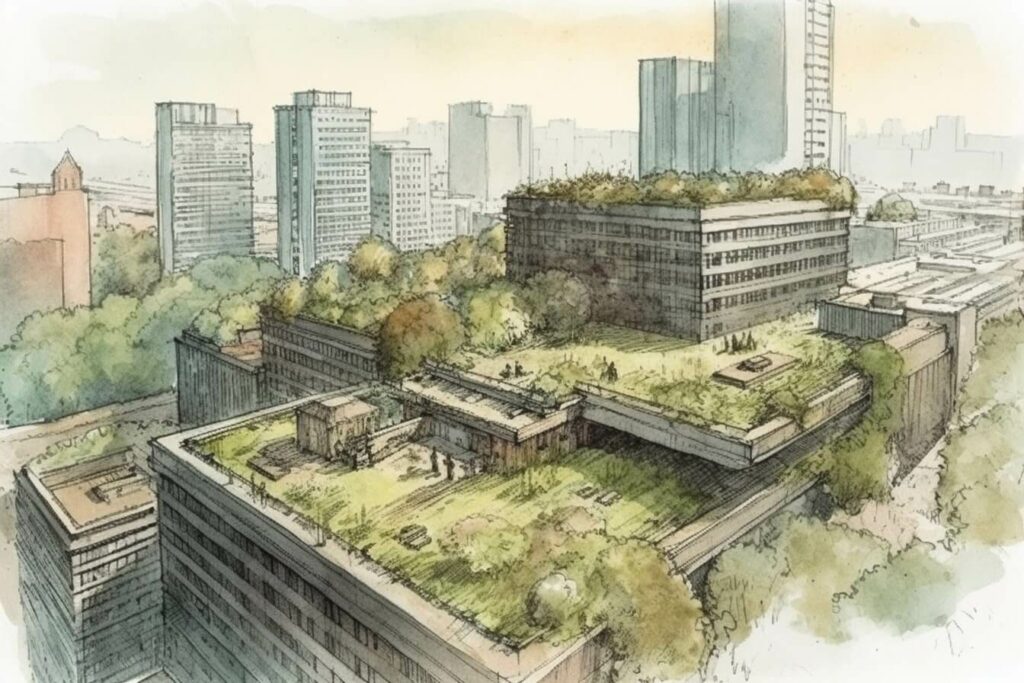



A 2-day immersion into the future of sustainable construction
As an architect, interior designer, or member of a construction company, you are likely aware of the increasing need for eco-friendly solutions in your projects. With the growing concerns about climate change, resource depletion, and environmental degradation, adopting sustainable practices in the construction industry is more critical than ever.
Green building materials help reduce the negative environmental impact of construction projects and contribute to healthier, more energy-efficient, and cost-effective spaces for occupants.
In this article, we’ll introduce you to the top 5 green building materials that can revolutionize your projects, providing benefits for the environment and the people who use the spaces you create. We’ll discuss each material’s unique features, advantages, and potential applications to help you make informed decisions for your next project.
So, buckle up and get ready to explore the world of green building materials. that can help you significantly impact the environment and reduce the carbon footprint of your projects! Let’s dive right in!


Green Building Materials #1: Recycled Steel
Environmental benefits
Recycled steel is a superior eco-friendly alternative to conventional steel production, boasting many environmental benefits. By opting for recycled steel in your construction projects, you directly contribute to reducing greenhouse gas emissions and conserving precious natural resources. The process of steel recycling consumes significantly less energy than traditional steel production, resulting in lower carbon emissions. That’s why we chose it from other green building materials.
Furthermore, recycling steel drastically reduces the demand for mining activities, often associated with deforestation, soil erosion, water pollution, and habitat destruction. By choosing recycled steel as one of your green building materials, you’re actively promoting a sustainable, circular economy where resources are continuously reused, thus minimizing waste and environmental damage.
Cost-effectiveness of these Green Building materials
In addition to its environmental advantages, recycled steel is a highly cost-effective choice for construction projects. The energy-efficient production process, which requires less fuel, translates to lower manufacturing costs that are ultimately passed on to the consumer.
The durability and strength of recycled steel are comparable to traditional steel, ensuring a long-lasting, low-maintenance material for your construction projects. This, in turn, leads to long-term savings, as less frequent repairs or replacements will be required. Moreover, recycled steel, as one of the green building materials is highly versatile and can be used in various applications, including structural supports, roofing, and cladding, making it an economically attractive option for architects, interior designers, and construction companies.
Green Building Materials #2: Insulated Concrete Forms (ICFs)
Energy efficiency
Insulated Concrete Forms (ICFs) are innovative, energy-efficient building materials consisting of hollow, interlocking blocks made from expanded polystyrene (EPS), polyurethane foam, or other insulating materials filled with concrete upon installation. The combination of the insulating material and the concrete core creates a highly effective thermal barrier, substantially reducing the transfer of heat and cold between the interior and exterior of a structure. That’s why we chose it from other green building materials.
The exceptional insulation performance of these green building materials reduces the need for energy-intensive heating and cooling systems, resulting in significantly lower energy consumption for your project. By lowering your project’s energy usage, you can effectively reduce its carbon footprint and contribute to a more sustainable built environment.
Durability of these Green Building materials
ICFs are highly regarded for their strength, durability, and resilience against various environmental factors. The concrete core, encased within the insulating blocks, provides excellent resistance to moisture, mold, and pests, contributing to the longevity of the structures built with ICFs.
This increased durability translates to fewer maintenance requirements and lower long-term costs, as structures built with ICFs are less likely to require repairs or replacements due to environmental damage. Additionally, the concrete core of ICFs offers superior sound insulation, making it an ideal material for residential and commercial applications where noise reduction is a priority, such as multi-unit residential buildings, offices, or hotels. Consider this as one of your green building materials.


Green Building Materials #3: Bamboo
Sustainability
Bamboo is an incredibly sustainable building material, thanks to its rapid growth rate and ability to regenerate without replanting. As a giant grass species, bamboo can be harvested every 3-5 years, allowing for a continuous supply without putting undue pressure on natural resources. This renewable nature of bamboo makes it an excellent choice for eco-conscious architects, interior designers, and construction companies looking to minimize their environmental impact. That’s why we chose it from other green building materials.
By choosing bamboo as one of your green building materials, you reduce the need for traditional timber, which often involves deforestation and the associated negative environmental consequences, such as habitat destruction, loss of biodiversity, and increased carbon emissions. Moreover, bamboo’s extensive root system helps prevent soil erosion, promoting its environmental benefits.
Strength and versatility of these Green Building materials
Bamboo boasts a tremendous strength-to-weight ratio, rivaling that of traditional timber and even some steel alloys. This impressive characteristic makes it a viable alternative to conventional construction materials, with applications ranging from flooring and wall panels to structural supports and roofing.
In addition to its strength, bamboo offers a high degree of flexibility, making it an excellent choice for earthquake-resistant construction. Its ability to bend without breaking allows structures built with bamboo to withstand seismic events better, enhancing the safety and resilience of the buildings.
Bamboo’s aesthetic appeal, natural warmth, and unique appearance also make it a popular choice for interior design elements, adding a touch of sophistication and sustainability to any project.
Green Building Materials #4: Solar Panels
Renewable energy generation
Solar panels are an excellent addition to any green building project, as they harness the sun’s energy to generate clean, renewable electricity. This sustainable approach to power generation reduces reliance on fossil fuels, which are known to contribute significantly to greenhouse gas emissions and climate change. By integrating solar panels into your project, you actively participate in the global shift towards a more sustainable future and help combat the detrimental effects of fossil fuel consumption. That’s why we chose it from other green building materials.
In addition to their environmental benefits, solar panels can be seamlessly integrated into various types of buildings, including residential, commercial, and industrial structures. This versatility of these green building materials allows architects, interior designers, and construction companies to incorporate renewable energy generation into various projects.
Long-term cost savings of these Green Building materials
While the initial investment in solar panels can be substantial, their long-term cost savings are significant. By generating your electricity, you can substantially reduce or even eliminate your energy bills, resulting in considerable savings over time. As solar panels typically have 25-30 years or more lifespan, this financial benefit can be substantial for property owners.
Furthermore, many governments worldwide recognize the importance of promoting renewable energy and offer various solar panel installation incentives, grants, and tax credits. These financial incentives make solar panels an even more attractive option for those investing in sustainable energy solutions while reducing long-term energy costs.


Green Building Materials #5: Green Roofs
Temperature regulation
As one of the most popular green building materials, green roofs are an innovative approach to roofing that covers a building’s roof with vegetation, providing natural insulation and numerous environmental benefits. The vegetation layer, growing medium, and underlying layers create a natural barrier that helps regulate indoor temperatures by reducing heat transfer through the roof. That’s why we chose it from other green building materials.
Green roofs absorb and dissipate heat during hot summer months, minimizing the need for energy-intensive air conditioning systems. In colder months, they provide an insulating layer, reducing heat loss and decreasing the need for heating systems. This temperature regulation results in lower energy consumption, ultimately reducing greenhouse gas emissions and creating a more sustainable built environment. This is a serious possibility between green building materials that must be considered in green building projects.
Stormwater management of these Green Building materials
Another significant benefit of green roofs is their ability to manage stormwater. The vegetation and growing medium can absorb and retain considerable rainwater, reducing stormwater runoff flow from a building’s roof. This reduced runoff can help mitigate the risk of flooding in urban areas, where large amounts of impervious surfaces often exacerbate stormwater management issues.
In addition to their water retention capabilities, green roofs can improve overall water quality. The vegetation on green roofs can filter pollutants, such as heavy metals and excess nutrients, from the rainwater as it percolates through the growing medium. This natural filtration process can help protect local water bodies from contamination, promoting healthier ecosystems and better overall water quality.
By incorporating green roofs into your construction projects as one of your green building materials, you can achieve significant environmental benefits, enhance the energy efficiency of your buildings, and contribute to more sustainable, resilient urban spaces.
Top 5 Green Building Materials: Conclusion
Embracing sustainable construction practices is more crucial than ever in today’s rapidly changing world. As an architect, interior designer, or construction company, you play a vital role in shaping the built environment and its impact on our planet.
By incorporating green building materials such as recycled steel, insulated concrete forms, bamboo, solar panels, and green roofs into your projects, you can create environmentally friendly, energy-efficient, and durable spaces that benefit both people and the planet.
Opting for eco-friendly alternatives demonstrates your commitment to sustainable practices and contributes to healthier, more comfortable, and cost-effective spaces for occupants. Moreover, these materials and technologies can enhance your projects’ aesthetic appeal and functionality, setting them apart from conventional designs.
So, go ahead and positively impact the environment, society, and future generations by choosing eco-friendly building materials and sustainable solutions for your next project. Together, we can create a more sustainable world, one building at a time!
Top 5 Green Building Materials: FAQs
1. Can recycled steel be used for structural applications?
Yes, recycled steel maintains the same strength and durability as traditional steel, making it suitable for structural applications in construction projects. It is an eco-friendly alternative that reduces greenhouse gas emissions and conserves natural resources. Consider it as one of your green building materials.
2. What are the primary benefits of using insulated concrete forms?
ICFs offer improved energy efficiency, durability, and sound insulation compared to traditional concrete construction methods. They provide exceptional thermal performance, reducing heating and cooling costs, and are resistant to moisture, mold, and pests.
3. Is bamboo suitable for use in humid climates?
Yes, bamboo is resistant to moisture and can be used in humid climates. Proper treatment and maintenance, such as using appropriate finishes and ensuring adequate ventilation, can enhance its durability and performance in moisture-rich environments.
4. How long do solar panels typically last as one of the most prominent green building materials?
Solar panels can last up to 25-30 years or more, with minimal degradation in efficiency over time. Regular maintenance and cleaning can help prolong their lifespan, ensuring you continue benefiting from their renewable energy generation and cost savings for years.
5. Are green roofs suitable for all types of buildings?
Green roofs can be installed on various residential, commercial, and industrial structures. However, structural considerations, such as weight limitations and load-bearing capacity, must be considered. It’s essential to consult a professional to determine if a green roof is appropriate for your project and ensure proper design, installation, and maintenance. It is a reasonable choice among other green building materials.






A 2-day immersion into the future of sustainable construction
If you need our services in the Portuguese language, click here.